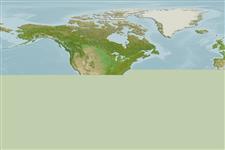Environment: milieu / Zona climática / intervalo de profundidade / distribution range
Ecologia
marinhas; estuarina pelagic-neritic; intervalo de profundidade ? - 35 m (Ref. 26912). Tropical; 23°N - 27°S, 85°W - 32°W (Ref. 189)
Western Atlantic: Antilles, Trinidad south to Brazil; also Venezuela to Panama and Honduras but not Gulf of Mexico. Meristic data tends to support three geographic units: South America (east Colombia, Venezuela south to Brazil); Antillean (and some islands off Venezuela); West Caribbean (Gulf of Honduras).
Tamanho / Peso / Idade
Maturidade: Lm ? range ? - ? cm
Max length : 14.5 cm TL macho/indeterminado; (Ref. 124483); common length : 10.0 cm TL macho/indeterminado; (Ref. 5217); peso máx. publicado: 21.29 g (Ref. 124483)
Espinhos dorsais (total) : 0; Espinhos anais: 0; Raios anais : 17 - 21. Snout long and pointed, only slightly less than eye diameter; maxilla long, tip pointed, reaching almost to gill opening, teeth near tip somewhat enlarged; gill cover canals of panamensis-type; pseudobranch longer than eye diameter, with 30 or more filaments, extending onto inner face of operculum. First pectoral fin ray filamentous. Silver stripe along flank about eye diameter.
Body shape (shape guide): elongated; Cross section: oval.
A schooling species occurring in coastal waters. Trawled down to 25 m off Brazil, but equally taken in shore seines and recorded in salinities of 7.94-8.21 ppt in the Canal de Santa Cruz, Pernambuco, Brazil (Ref. 189).
Ciclo de vida ou comportamento de acasalamento
Maturidade | Reprodução | Desova | Ovos | Fecundidade | Larvas
Spawn in school (Ref. 205).
Whitehead, P.J.P., G.J. Nelson and T. Wongratana, 1988. FAO Species Catalogue. Vol. 7. Clupeoid fishes of the world (Suborder Clupeoidei). An annotated and illustrated catalogue of the herrings, sardines, pilchards, sprats, shads, anchovies and wolf-herrings. FAO Fish. Synop. 125(7/2):305-579. Rome: FAO. (Ref. 189)
Status na Lista Vermelha da UICN (Ref. 130435: Version 2025-1)
Ameaça para os humanos
Harmless
Uso pelos humanos
Pescarias: pouco comercial
Ferramentas
Relatórios especiais
Baixar XML
Fontes da internet
Estimates based on models
Preferred temperature (Ref.
123201): 27 - 28.2, mean 27.6 °C (based on 421 cells).
Índice de diversidade filogenética (Ref.
82804): PD
50 = 0.5000 [Uniqueness, from 0.5 = low to 2.0 = high].
Bayesian length-weight: a=0.00447 (0.00271 - 0.00737), b=3.20 (3.06 - 3.34), in cm total length, based on LWR estimates for this species & Genus-body shape (Ref.
93245).
Nível Trófico (Ref.
69278): 3.4 ±0.4 se; based on size and trophs of closest relatives
Resiliência (Ref.
120179): médio(a), tempo mínimo de duplicação da população 1,4 - 4,4 anos (Fec=1,644 (batch fecundity)).
Fishing Vulnerability (Ref.
59153): Low vulnerability (10 of 100).
🛈
